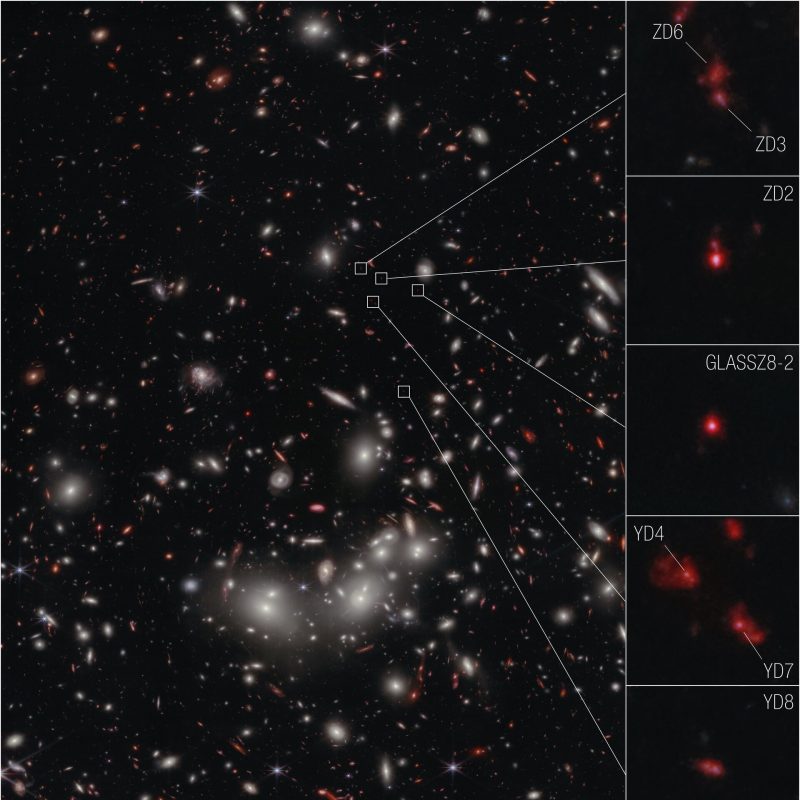
Early-universe prequel: Galaxies in distant space
We know our universe contains gigantic galaxy clusters in space. Each galaxy is made of millions to billions of stars. And each cluster is made of hundreds to thousands of galaxies, bound together by gravity. And the clusters group into even-larger superclusters, with vast voids in between. Now consider that looking far away in space is the same as looking back in time. That’s why we can use the most powerful of modern telescopes to peer into the early universe, and see an early-universe prequel – a precursor, a forerunner – to one of the huge galaxy clusters we see today.
In other words, what you see above is an image – from the new Webb Space Telescope, which launched in late 2021 and was placed at the L2 point in the Earth-sun system – of seven exceedingly distant galaxies. They are young galaxies in the early universe, confirmed at a distance that astronomers refer to as redshift 7.9. That distance away in space correlates to 650 million years after the Big Bang, the event that gave rise to our universe 13.8 billion years ago. The European Space Agency said in late April:
This makes them the earliest galaxies yet to be spectroscopically confirmed as part of a developing cluster.
These results have been published in The Astrophysical Journal Letters.
How astronomers noticed these galaxies
Webb wasn’t the first space telescope to see these galaxies. The Hubble Space Telescope’s Frontier Fields program – which ran from 2013 to 2017 – also spotted them. It was Frontier Fields that first established the galaxies as candidates for further observation. ESA said:
Frontier Fields dedicated Hubble time to observations using gravitational lensing, to observe very distant galaxies in detail. However, because Hubble cannot detect light beyond near-infrared, there is only so much detail it can see. Webb picked up the investigation, focusing on the galaxies scouted by Hubble and gathering detailed spectroscopic data in addition to imagery.
See a Wikipedia entry containing a list of deep fields, in part from Frontier Fields
What Webb brings to the table
The James Webb Space Telescope is an international collaboration among NASA, the European Space Agency (ESA), and the Canadian Space Agency (CSA). ESA said:
Astronomers used Webb’s Near-Infrared Spectrograph (NIRSpec) instrument to precisely measure the distances and determine that the galaxies are part of a developing cluster. Galaxy YD4, previously estimated to be at a further distance based on imaging data alone, was able to be more accurately placed at the same redshift as the other galaxies.
Before Webb, astronomers did not have high resolution imaging or spectral infrared data available to do this type of science.
At extreme distances, astronomers use the redshift reference to account for the fact that, as the universe expands, wavelengths of light are stretched and “shifted” to redder wavelengths, which are longer. Shorter wavelengths, for example ultraviolet and X-ray, are toward the bluer end of the electromagnetic spectrum. So extreme distances in the early universe are referenced by how much the light emitted there has been shifted as it travelled through space to be detected by a telescope.
Bottom line: We know our universe consists of gigantic galaxy clusters in space. And we know that looking far away in space equals looking back in time. Here’s an early-universe prequel to a huge galaxy cluster.











